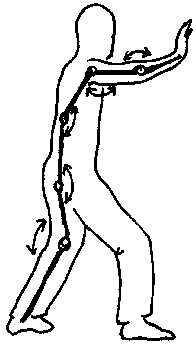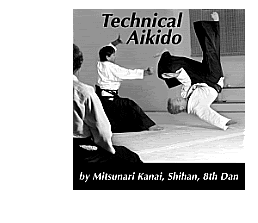"There are at two kinds of strength or power. The first is contracting strength that you use and experience when you lift something, or pull something and your muscles contract toward you. The other is a different kind of strength that occurs when you extend your muscles, such as when you push something or throw a ball. In that type of strength you are transferring power toward or into the object.
"The way one experiences these two kinds of strength is different. The first way, contracting, feels more like what we might call strength or power because it feels more like we are doing something with our person-al muscle strength. The second, extending, is more difficult to feel and may seem like we aren't really doing anything with our personal strength. It may actually seem as if nothing is happening.
"In Aikido we want to use the second kind of strength or power, not the first.
"There is a way that we must coordinate our body to maximize the use of this second type of power. To understand this we must think about the body's joints and how power and energy moves through them. The joints must be kept soft and flexible so that they can transmit the extended power. In contracting power one can feel muscles tighten as the power moves through them to bring objects towards oneself. In extended power one must feel the joints open so that the power can be whipped through them and away from oneself.
"As power moves through each joint, there is an opportunity to multiply the power being transmitted. If you think of someone throwing a ball, you know that if you stand with your feet planted and only move at your shoulder you will be able to throw, but it will have a limited effect in terms of speed, power and direction. However, if as you throw, you step into the throw and keep your arm relaxed so that it swings freely at the shoulder, and continues to move fluidly through the elbow, wrist and hand, then you can achieve precise aim with great power and velocity. Each joint does not simply add power; rather it multiplies the power passing through it.
"In an Aikido throw the progression of how power flows through the joints is as follows: first from the hip to the shoulder, then through the elbow, then out the wrist, and finally through the hand. One can maximize the use of the hip by maintaining a low center and pivoting it into the throw at the time of completion. One can add more power by pushing off the back leg using the ball of the rear foot, which, like the front foot, should be pointed in the direction of the throw. In this way power generated from the toes, ankle, knee and upper leg can be added to the projection.
"This entire effort is coordinated to occur simultaneously so that nage's total body weight/energy is transmitted to uke. It is important to note that the center (the mass centered in the hips) must be extended into the throw and that the power starts and emanates from there.
"The final factor in both the generation and transmission of power in a technique is to coordinate the technique's completion with nage's exhalation. Nage should project both uke and his/her breath at the same time. This is done in a manner wherein there is a sound made like "haa" when the breath is consciously expelled out and away.
"If you had to think of this sequentially: first the feet move to the firm placement that serves as the rooted foundation upon which the hips turn as the center is extended and intensified by the motion of the rear leg. This power is then snapped or whipped through the extended muscles and joints and is successively magnified as the power is transmitted through the upper body and into uke. However, these events are completed and coordinated in such rapid succession that they all occur virtually simultaneously.
"To do this, nage must keep his or her body, and especially the joints, soft and pliable. But there are also additional reasons to keep the joints soft and pliable.
"One is to allow nage to receive the power of the attack without a collision, without "clashing". In this regard, it is also important to hold the arms extended and slightly curved through the tegatana (hand blades). The use of extended or curved arms is important for both uke and nage. For uke, this creates a flexibility that enables uke to attack with power and speed. For nage, it serves as a cushion that allows nage to receive uke's attack without injuring him or her. If nage is too stiff and rigid, then uke impacts against nage (and nage may lose his balance in the collision) rather than being accepted or absorbed by nage's flexible body posture.
"By holding the arms in such a manner they also become much more sensitive and this allows nage to more accurately feel uke's movement and power. Again, if nage is stiff and rigid then this is not possible. Also, if nage is soft, then nage can load uke's power into his/her joints in a similar way as one might store energy by winding and tightening a spring. Uke's energy can then be redirected back into uke while allowing nage to control the amount of power and velocity required or desired.
"Finally, although there are many similarities between throwing a ball and throwing an opponent, there is one critical difference. When one throws a ball it is desirable to have all the energy possible transmitted to the object. Because of this one may wish to throw one's own balance into the ball.
"In an Aikido throw, which has a martial arts application, this is not practical. One must be ready for the next attack as uke is being thrown, therefore nage must keep his/her balance. Consequently, it is critically important to maintain at all times a low, firm center and good upright posture. Nage must make sure that both feet remain fully planted on the ground and safeguard his/her balance throughout the entire technique."






 Trả lời kèm Trích dẫn
Trả lời kèm Trích dẫn